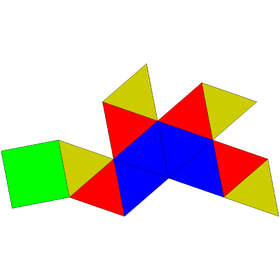|
Gyroelongated square pyramid
In geometry, the gyroelongated square pyramid is the Johnson solid that can be constructed by attaching an equilateral square pyramid to a square antiprism. It occurs in chemistry; for example, the square antiprismatic molecular geometry. ConstructionThe gyroelongated square pyramid is composite, since it can constructed by attaching one equilateral square pyramid to the square antiprism, a process known as the gyroelongation.[1][2] This construction involves the covering of one of two square faces and replacing them with the four equilateral triangles, so that the resulting polyhedron has twelve equilateral triangles and one square.[3] The convex polyhedron in which all of the faces are regular is the Johnson solid, and the gyroelongated square pyramid is one of them, enumerated as , the tenth Johnson solid.[4] PropertiesThe surface area of a gyroelongated square pyramid with edge length is:[3] the area of twelve equilateral triangles and a square. Its volume:[3] can be obtained by slicing the square pyramid and the square antiprism, after which adding their volumes.[3] It has the same three-dimensional symmetry group as the square pyramid, the cyclic group of order eight. Its dihedral angle can be derived by calculating the angle of a square pyramid and square antiprism in the following:[5]
ApplicationsIn stereochemistry, the capped square antiprismatic molecular geometry can be described as the atom cluster of the gyroelongated square pyramid. An example is [LaCl(H References
See alsoExternal linksInformation related to Gyroelongated square pyramid |
||||||||||||||||||||||












